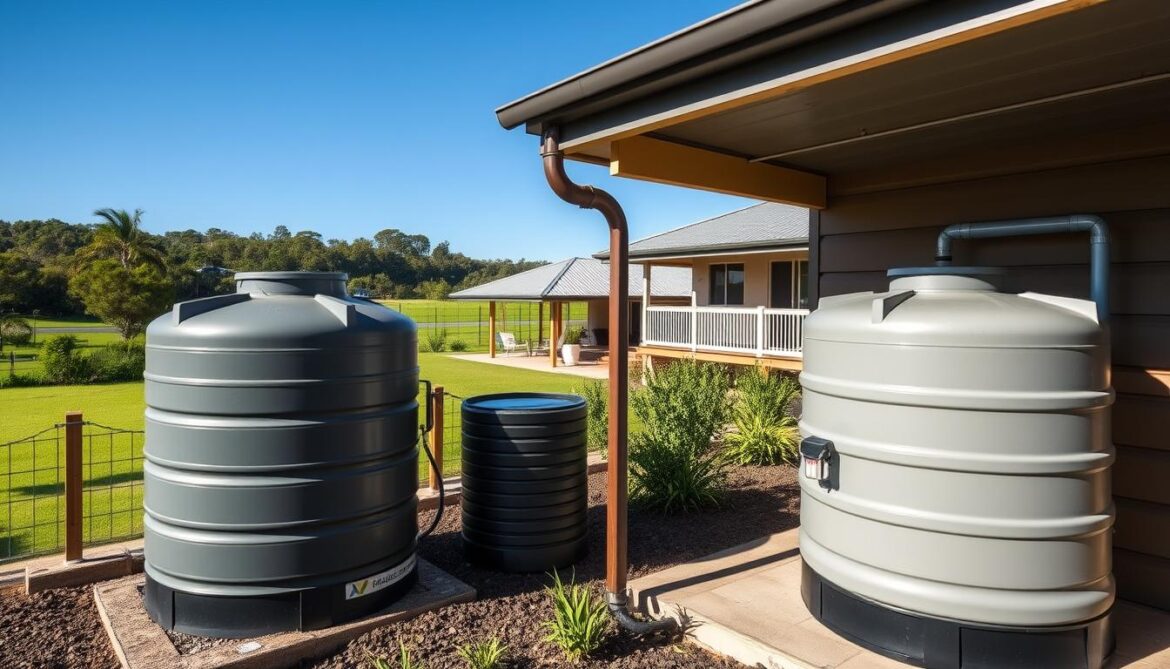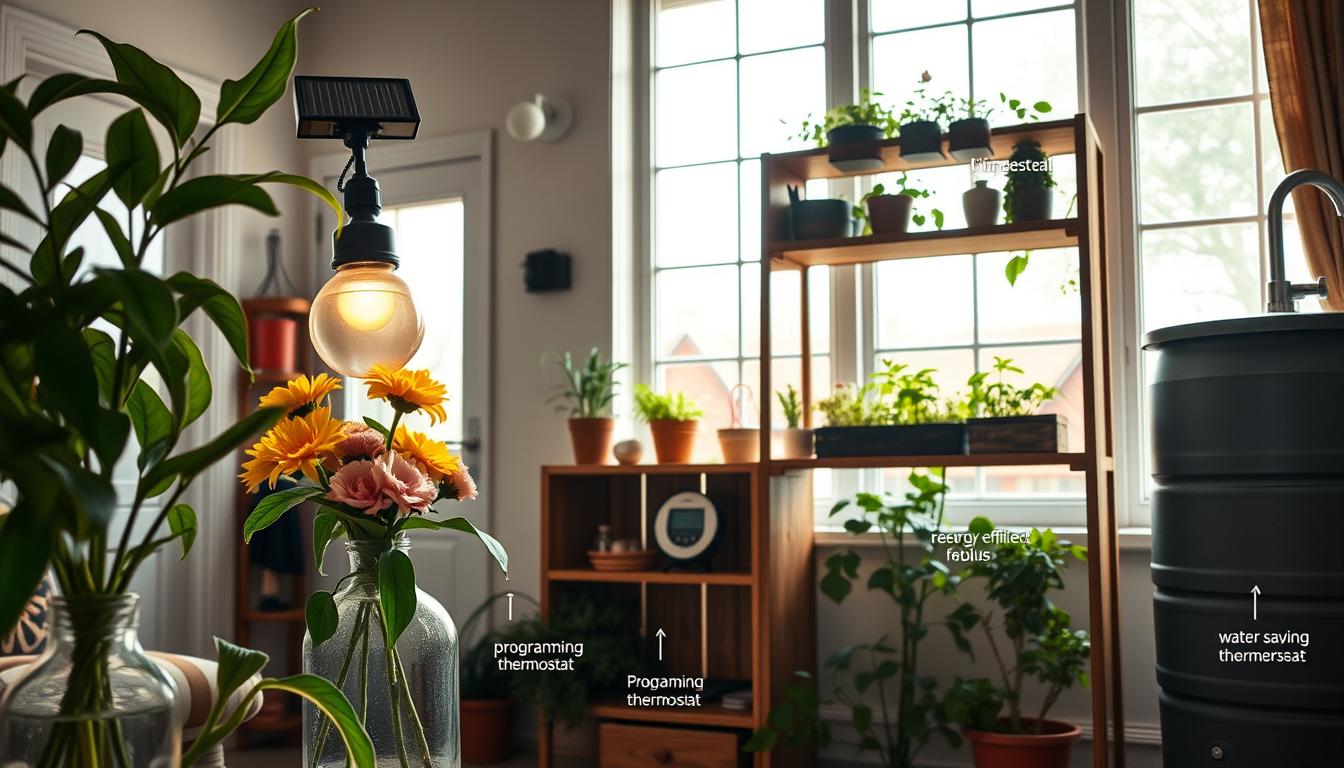Queensland’s abundant rainfall makes it an ideal location for rainwater harvesting, especially for those seeking self-sufficient, off-grid living. With average annual rainfall ranging from 600mm in western regions to over 2000mm in tropical north Queensland, capturing this natural resource can provide a sustainable water supply year-round. This comprehensive guide explores everything you need to know about implementing rainwater harvesting systems specifically designed for Queensland’s unique climate and regulatory environment.
Rainwater Harvesting Systems for Queensland Conditions
When designing a rainwater harvesting system for off-grid living in Queensland, it’s essential to consider the region’s unique climate patterns, including cyclone seasons in coastal areas and prolonged dry periods inland. Here’s a comparison of three effective system types that work well in Queensland’s diverse conditions.
| System Type | Best For | Components | Advantages | Limitations |
| Basic Gravity-Fed System | Small households, budget-conscious setups | Roof catchment, gutters, first-flush diverter, tank, gravity-fed outlets | No electricity required, simple maintenance, lower cost | Limited pressure, elevated tank placement needed |
| Pressurized Pump System | Standard households with modern appliances | Roof catchment, gutters, first-flush diverter, tank, pump, pressure tank, filtration | Consistent water pressure, suitable for all household uses | Requires electricity, more maintenance, higher cost |
| Hybrid Solar-Powered System | Complete off-grid living, remote properties | Roof catchment, gutters, first-flush diverter, tank, solar-powered pump, battery backup, advanced filtration | Energy independent, reliable in power outages, environmentally friendly | Highest initial investment, complex installation |
Essential Components Breakdown
Tank Options for Queensland
Selecting the right tank is crucial for Queensland’s climate extremes:
- Polyethylene Tanks: Lightweight, affordable, and UV-resistant. Ideal for most Queensland locations but ensure they’re certified for drinking water use.
- Steel Tanks: Durable and fire-resistant, making them suitable for bushfire-prone areas. Look for Aquaplate or Zincalume with food-grade liners.
- Concrete Tanks: Excellent for underground installation, naturally alkaline (helps neutralize acidic rainwater), and cyclone-resistant. Perfect for coastal Queensland regions.
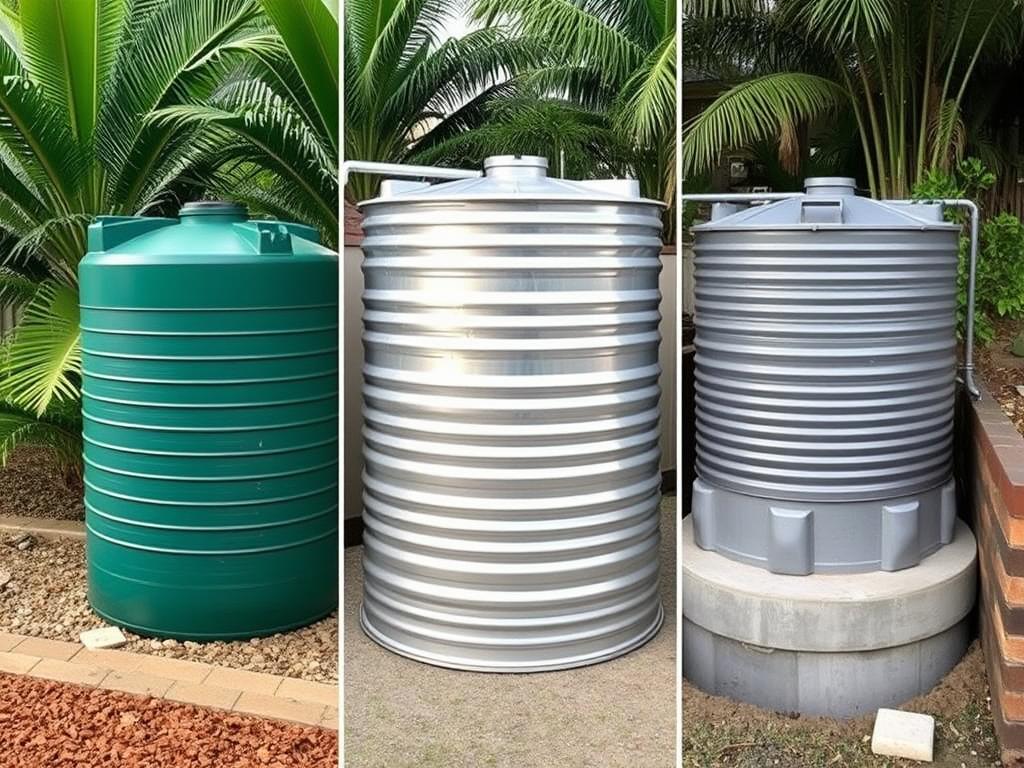
Filtration Systems
Queensland’s climate demands effective filtration:
- Mesh Filters: Basic debris removal, essential for all systems. Use 0.955mm mesh as per Queensland Health recommendations.
- UV Filtration: Highly effective against bacteria and pathogens common in warm Queensland conditions. Requires electricity.
- Ceramic Filters: Excellent for removing sediment and bacteria without power. Good option for remote Queensland properties.
- First-Flush Diverters: Critical in Queensland to divert initial contaminated water after dry periods. Size according to roof area.
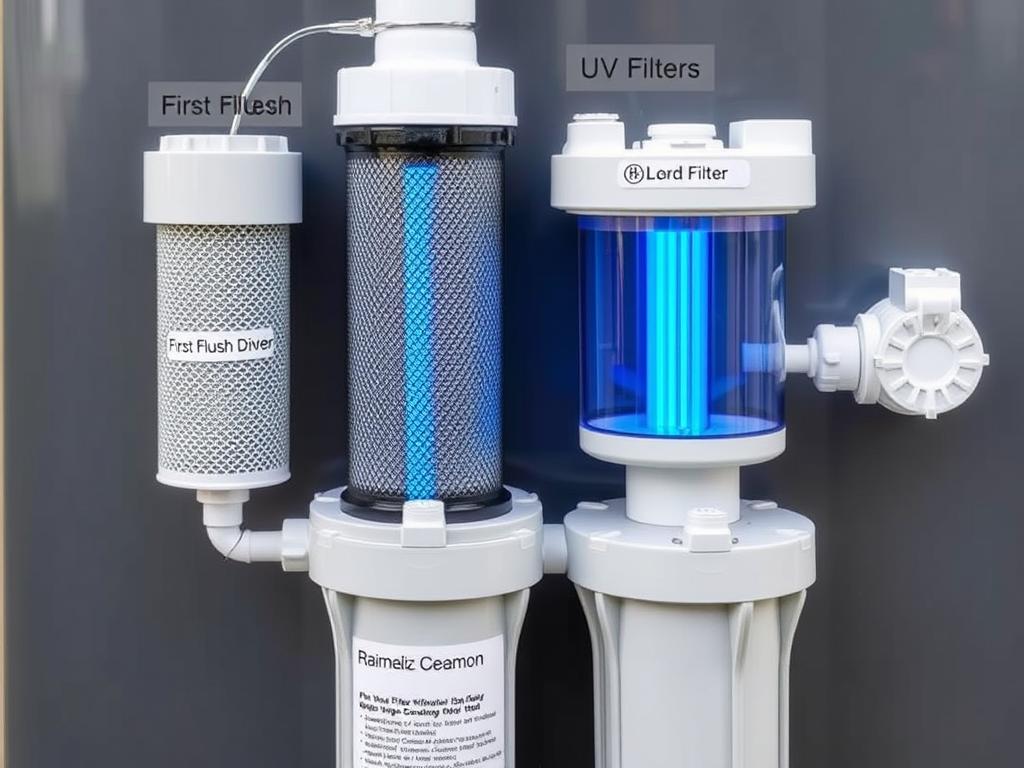
Design & Installation Considerations for Queensland
Roof Catchment Calculations
To determine your potential water collection in Queensland:
- Measure your roof’s catchment area in square meters
- Find your location’s average annual rainfall (mm) from Bureau of Meteorology data
- Multiply: Roof area × Rainfall × 0.8 (efficiency factor) = Litres collected annually
For example, a Brisbane home with 200m² roof and 1000mm annual rainfall could collect: 200 × 1000 × 0.8 = 160,000 litres annually.
Cyclone-Proofing Requirements
For Queensland’s cyclone-prone areas:
- Install cyclone-rated tank straps (mandatory in coastal regions)
- Use reinforced concrete bases for tank stability
- Select impact-resistant tank materials
- Install protected inlet and overflow systems
- Consider underground tank options for extreme weather areas
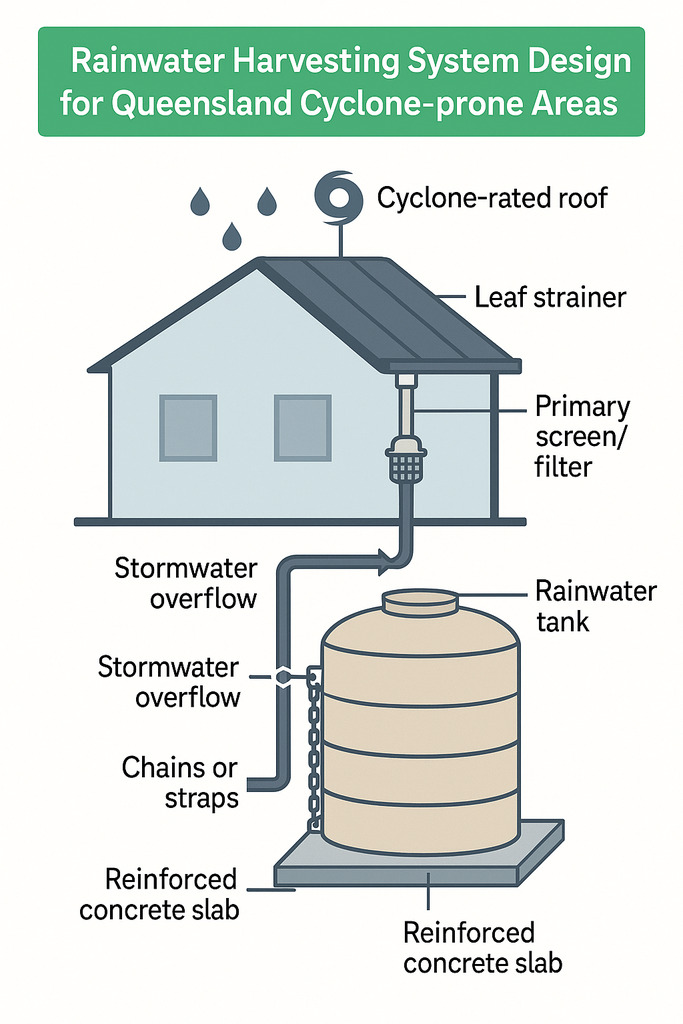
Seasonal Maintenance Schedule for Queensland
| Season | Maintenance Tasks | Queensland-Specific Considerations |
| Pre-Wet Season (October-November) | Clean gutters, check roof catchment, inspect tank for cracks | Critical timing before heavy summer rains to maximize collection |
| Wet Season (December-March) | Check mosquito screens, monitor overflow systems, inspect for leaks | Dengue risk management, overflow handling for intense rainfall events |
| Dry Season (April-September) | Clean filters, test water quality, check pump operation | Water conservation strategies, system efficiency checks |
| Annually | Professional system inspection, tank desludging if needed, replace UV bulbs | Compliance with Queensland Health guidelines, cyclone season preparation |
Need Help Designing Your Queensland Rainwater System?
Our experts can help design a custom rainwater harvesting system optimized for your specific Queensland location, household needs, and budget.
Cost Analysis: Queensland Rainwater Harvesting Systems
Understanding the costs involved in setting up a rainwater harvesting system in Queensland helps in planning and budgeting effectively. While initial setup costs may seem significant, the long-term savings and benefits make it a worthwhile investment for off-grid living.
Setup Costs Breakdown
| Component | Average Cost Range (AUD) | Factors Affecting Cost |
| Tanks (5,000L-20,000L) | $1,200 – $5,000 | Material (poly, steel, concrete), size, delivery distance |
| Filtration Systems | $500 – $3,000 | Basic vs. advanced (UV, ceramic), drinking water requirements |
| Pumps & Pressure Systems | $400 – $2,500 | Manual vs. automatic, solar-powered options, capacity |
| First-Flush Diverters | $150 – $500 | Size, automatic vs. manual, roof area |
| Guttering & Downpipes | $1,000 – $3,000 | House size, gutter guards, material quality |
| Installation Labour | $1,500 – $5,000 | System complexity, site accessibility, regional rates |
| Total System Cost | $4,750 – $19,000 | System size, complexity, location in Queensland |
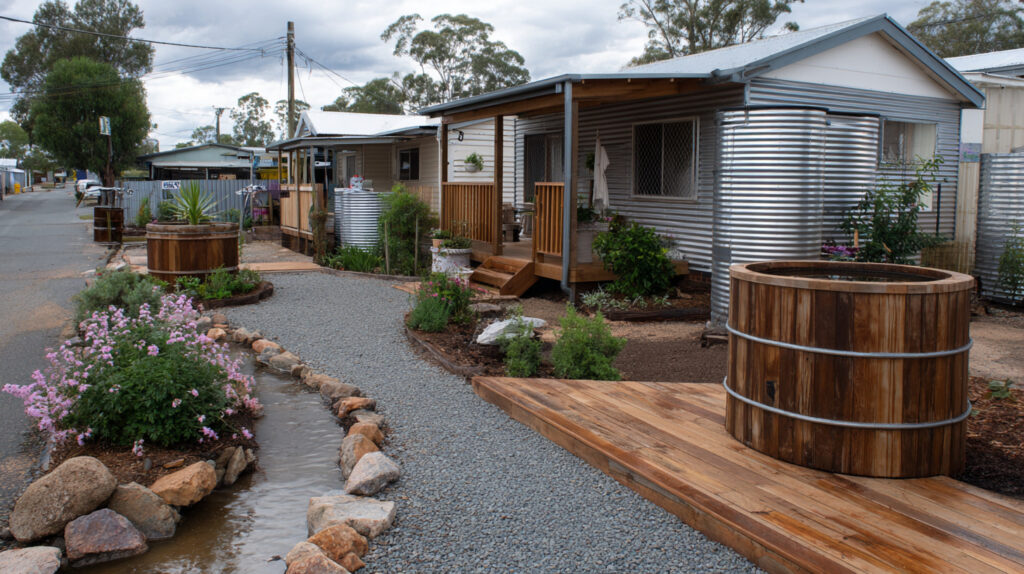
Regional Cost Factors in Queensland
Geographic Considerations
Costs vary significantly across Queensland regions:
- Far North Queensland: Higher delivery costs for materials, but potentially smaller tank requirements due to consistent rainfall
- Western Queensland: Larger storage needs due to rainfall variability, higher transport costs
- Southeast Queensland: More competitive pricing due to greater supplier options, but stricter council requirements
- Coastal Areas: Additional costs for cyclone-proofing (approximately 15-20% premium)
Property-Specific Factors
Your specific property details impact costs:
- Roof Material: Metal roofs are ideal and cost-effective; tile roofs may require additional filtration
- Water Usage: Household (50-200L per person daily) vs. agricultural needs (significantly higher)
- Site Accessibility: Remote properties face 20-30% higher installation costs
- Soil Type: Sandy or unstable soils require enhanced tank bases (additional $500-1,000)
Long-Term Savings & ROI
Water Bill Savings
A typical Queensland household using 200,000L annually could save:
- 5-Year Savings: $3,000-$5,000 (based on current QLD water rates)
- 10-Year Savings: $7,000-$12,000 (accounting for projected rate increases)
- Average ROI timeframe: 5-8 years for complete systems
Real example: A Cairns homeowner with a 15,000L steel tank and UV filtration reduced water bills by 60%, achieving complete ROI in just 6 years.
Available Rebates & Incentives
Queensland offers several financial incentives:
- Local council rebates (vary by region, typically $500-1,500)
- Queensland Government’s HealthyHome initiative (up to $1,000 for water-efficient systems)
- Tax deductions for rural properties using rainwater for income-producing activities
- Reduced water connection fees for new builds with rainwater systems
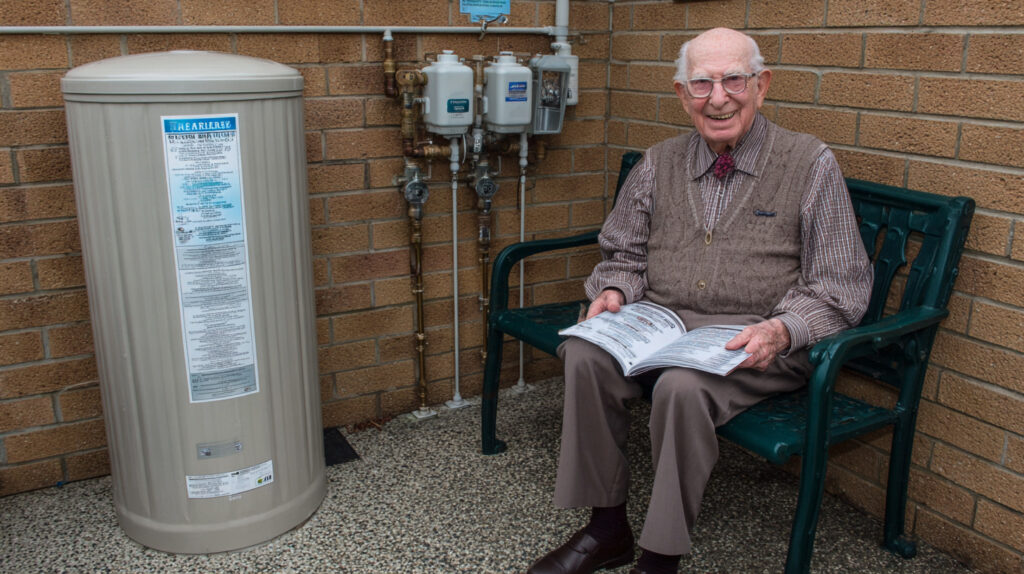
Calculate Your Potential Savings
Use our free Queensland Rainwater Savings Calculator to estimate your potential water bill savings and system ROI based on your location and household size.
Queensland Regulations & Compliance for Rainwater Harvesting
Understanding and adhering to Queensland’s specific regulations for rainwater harvesting systems is essential for legal compliance and ensuring system safety. These regulations vary depending on your location within Queensland and how you intend to use the harvested water.
Queensland Development Code Requirements
Queensland Development Code MP 4.2 sets out the requirements for water savings in new residential buildings. For off-grid properties, understanding these regulations helps ensure your system meets minimum standards even when not connected to municipal water.
Key Regulatory Requirements
- Minimum tank capacity requirements (generally 5,000L for off-grid systems)
- Mandatory first-flush diversion devices
- Backflow prevention if connected to any municipal supply
- Compliance with Plumbing Standard AS/NZS 3500
- Mosquito-proof screens on all openings
- Appropriate overflow handling provisions
Regional Variations
- Far North Queensland: Additional cyclone rating requirements
- Drought-declared areas: Potential water use restrictions
- Heritage overlay zones: Aesthetic requirements for visible tanks
- Bushfire-prone areas: Additional fire safety requirements
- Flood zones: Elevated or secured tank installations
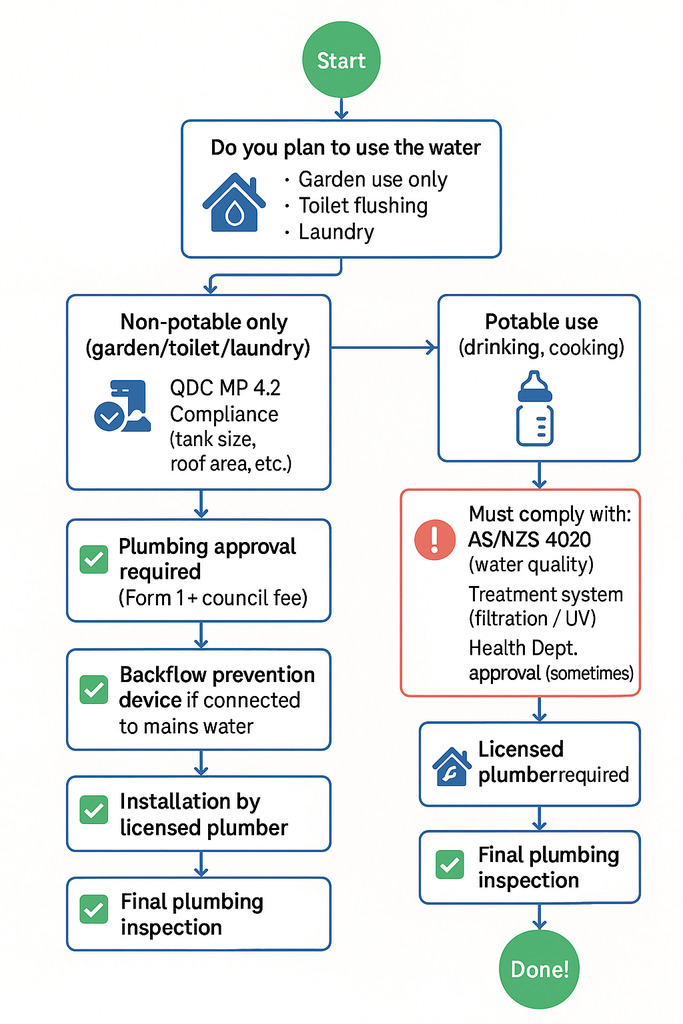
Permit Requirements
Depending on your specific situation, you may need various permits for your rainwater harvesting system in Queensland:
| Scenario | Permit Required | Approving Authority | Typical Cost |
| Tanks larger than 10,000L | Development Approval | Local Council | $300-$800 |
| Heritage-listed properties | Heritage Alteration Permit | Queensland Heritage Council | $400-$1,200 |
| Plumbing connections to house | Plumbing Compliance Permit | Local Council Plumbing Department | $200-$500 |
| Excavation for underground tanks | Excavation Permit | Local Council | $150-$400 |
Drinking Water Safety Standards
NHMRC Guidelines
If using rainwater for drinking, your system must comply with the National Health and Medical Research Council (NHMRC) Australian Drinking Water Guidelines, which specify:
- Maximum acceptable levels for microorganisms
- Chemical and physical quality parameters
- Testing frequency recommendations
- Treatment requirements based on risk assessment
Queensland Health Requirements
Queensland Health provides additional guidelines specific to the state’s conditions:
- Tank material must be approved for potable water
- Mandatory signage for non-potable systems
- Regular water quality testing recommendations
- Specific maintenance schedules for tropical regions
- Additional treatment for high-risk areas (e.g., mining regions)
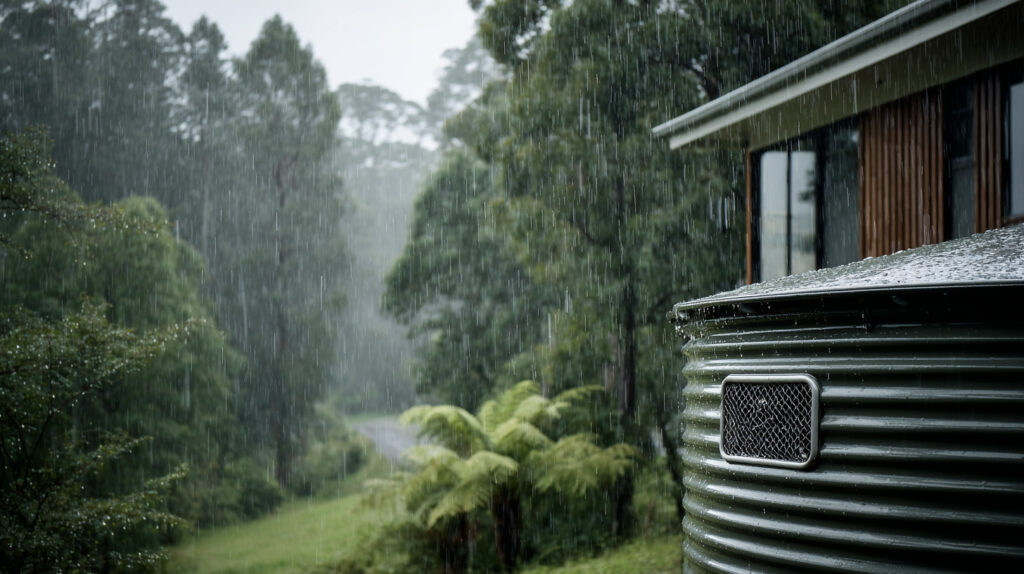
Important: All rainwater tanks used for drinking water must be clearly labeled as drinking water sources. Tanks used for non-potable purposes must display “NOT FOR DRINKING” signage as per Queensland Health regulations.
Real-World Compliance Example
“When we installed our 20,000L concrete underground tank in the Sunshine Coast hinterland, we needed three different permits. The process took about 6 weeks, but having a licensed installer who understood Queensland regulations made everything much smoother. The council inspector was particularly concerned about our overflow management due to our sloped property.”
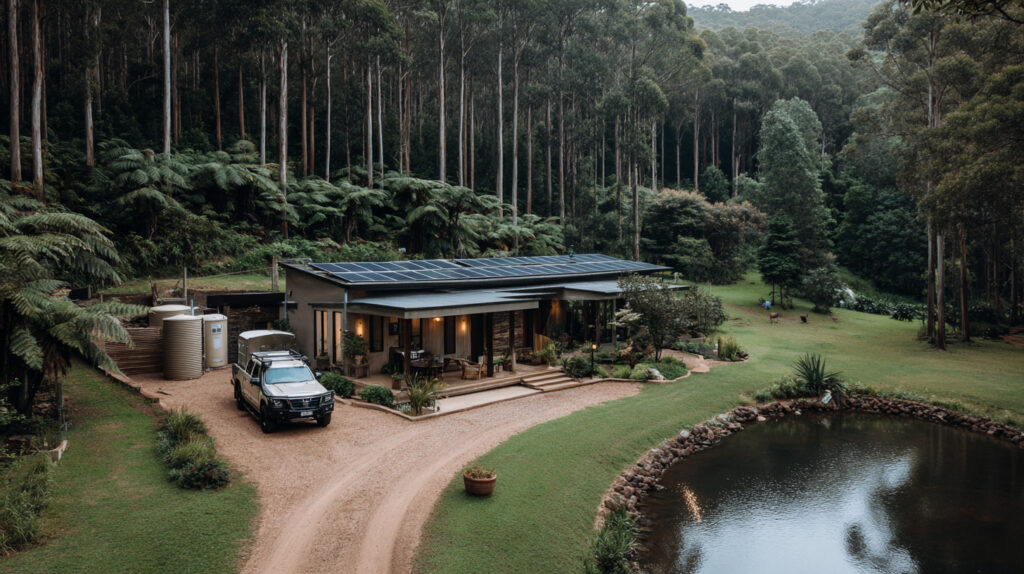
Ensure Your System Is Fully Compliant
Download our free Queensland Rainwater Harvesting Compliance Checklist to ensure your system meets all local regulations and safety standards.
Conclusion: Your Path to Off-Grid Water Independence in Queensland
Implementing a rainwater harvesting system for off-grid living in Queensland offers a sustainable, cost-effective solution for water independence. With Queensland’s favorable rainfall patterns and growing support for self-sufficient living, now is an ideal time to invest in this technology.
Key Takeaways
- Select a system type (gravity-fed, pressurized, or solar-hybrid) based on your specific needs and budget
- Factor in Queensland’s unique climate considerations, especially for cyclone-prone and drought-affected regions
- Calculate adequate storage capacity based on your roof area, local rainfall data, and household water needs
- Budget for the complete system, factoring in long-term savings and available rebates
- Ensure compliance with Queensland-specific regulations and safety standards
- Implement a regular maintenance schedule tailored to Queensland’s seasonal patterns
Queensland Resources
- Queensland Government’s Water-Wise Homes Initiative
- Queensland Health Drinking Water Guidelines
- Queensland Plumbing and Drainage Act
- Local council water conservation programs
- Bureau of Meteorology rainfall data for your specific location
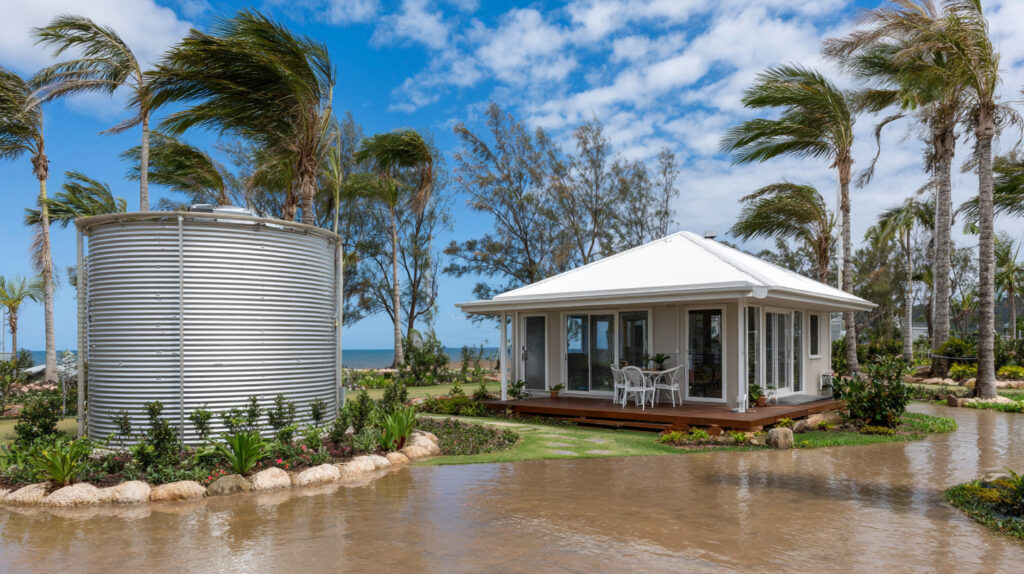
Ready to Start Your Off-Grid Water Journey?
Our Queensland-based experts can help design and implement the perfect rainwater harvesting system for your specific location, needs, and budget.

